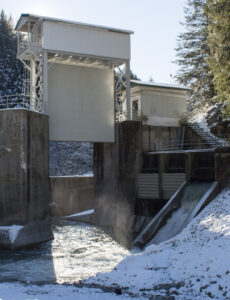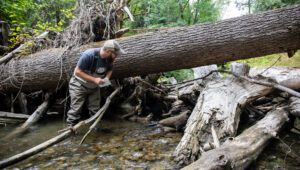It’s been 10 years since Snohomish County Public Utility District (PUD) relicensed its Jackson Hydroelectric Project on the Sultan River. Since that time, the utility has followed through on commitments made as part of the relicensing agreement to manage the project for healthy fish populations. In this interview, Natural Resources Manager Keith Binkley looks back on a decade of mitigation interventions, including modulating the temperature of water released and scheduling flows to support salmon at all stages of their life cycle.
Hydro Leader: Please tell us about your background and how you came to be in your current position.
Keith Binkley: I got my bachelor’s degree in wildlife management at North Carolina State University and my master’s in fisheries science from Montana State University. Then I consulted for many years in California, Idaho, Montana, and Washington. In 2002, I was selected for a fish biologist position at Snohomish County PUD and served in that capacity during the relicensing effort. For the last 10 years, I’ve served as the natural resources manager.
Hydro Leader: Please introduce Snohomish County PUD.

Everett’s historic diversion dam, allowing migratory fish access to
areas above the dam that had been blocked since 1929. Coho spawned
5 miles upstream after 2 weeks of the project being completed.
Keith Binkley: Snohomish County PUD was founded in 1936 and began water supply distribution in 1946. In 1949, the PUD became primarily an electric utility. We had few resources of our own and would basically purchase power from other entities and then distribute it within our service territory. We applied for a license with the Federal Energy Regulatory Commission (FERC) for a joint project that would both supply water for the City of Everett and generate power on the Sultan River. The license was issued in 1961; however, we initially proceeded only with the construction of the water supply reservoir, since the energy supply was not needed at that time. In 1976, we got a notification from the Bonneville Power Administration (BPA), which supplied the majority of our power, that it was not going to be able to meet our needs in the future. In response, we started developing the 112‑megawatt hydropower portion of the project, which would eventually be named the Henry M. Jackson Hydroelectric Project. Since that time, we’ve brought several additional small hydropower projects into our portfolio. Those are run-of-the-river facilities that don’t store water and that run when conditions allow, typically during the fall, winter, and spring, but not in the summer. We continue to be a major purchaser of power from the BPA. Our hydro operations constitute a small but significant portion of our portfolio, at about 7 percent.
Hydro Leader: How was the Jackson Hydro Project developed?
Keith Binkley: Before the facility was developed for hydro, it operated to deliver water to the City of Everett in Snohomish County. The reservoir is still a significant water source. In 1981, to develop it as a hydro facility as well, we raised the dam and reservoir by 90 feet, which increased its volume 4½ times. Then, we built the intake structure, power tunnel, penstock, and powerhouse. The original license for that operation expired in 2011, and we went through FERC’s relicensing process. Our current 45‑year license term goes from 2011 to 2056.
Hydro Leader: Please tell us about the relicensing process.
Keith Binkley: The relicensing effort took many years, and it was sometimes contentious, but ultimately, we were able to craft a settlement agreement that had assurances for the continued operation of the project for power generation purposes. It included measures that met the needs of the stakeholders, which included local towns, Snohomish County, the State of Washington, the Tulalip Tribes, the National Marine Fisheries Service, the U.S. Forest Service, the U.S. Fish and Wildlife Service, the National Park Service, and American Whitewater. While we were in the thick of the negotiations that led to the settlement agreement, we had back-to-back meetings every other week for months to work through the suite of issues and to negotiate how to move forward. These settlement discussions occurred in parallel to the relicensing processes, so a lot of activity was going on at all times.
Hydro Leader: What were the main stakeholder concerns that you had to address?
Keith Binkley: The Sultan River is used by a variety of salmon species, including chum, pink, Chinook, coho, and occasionally sockeye, as well as by steelhead trout. These species have variable life cycle and habitat requirements that do not always align with each other. One of the first and most important needs was to develop a minimum instream flow regime that met those species’ needs over the course of the year. There are also ramping requirements, which dictate how much we can move the river up and down when we discharge water. We also had to consider physical process flows, or releases that mimic the attributes of a free-flowing, unregulated river system. These process flows include elements for actions like flushing fine sediment from the gravel. We are required to carry out flushing flows twice a year; larger-volume channel maintenance flows on average once every 2 years; and really big, channel-forming flows about once every 10 years. We also have flows for upmigration and outmigration. Besides flows for fish needs, we also provide flows for whitewater recreation. These are all the add-ons to the base minimum flow regime. The schedule over the course of the year can get complex as we strive to meet the immediate needs of the various fish species and to create dynamic habitats for their use.
The annual precipitation in this basin is on the order of 165 inches, so a significant amount of inflow comes into the system. The capacity of the reservoir is probably only one-third of that volume. To meet our minimum flow requirements and our obligations for water supply, we have to be intentional in how we manage the reservoir. We generally try to take full advantage of the water and avoid spilling it out of the reservoir. That means we have stream gauges, we monitor the snowpack, and we typically draw down the reservoir in the fall in advance of the storm season. All this is mapped out in a schedule as well. We have what are called reservoir rule curves, which ensure that we meet all our obligations and minimize the risk of spill. If there is the risk of a drought, we may operate differently than we would otherwise.
Hydro Leader: Do your mitigation activities also involve the construction of fish channels or fish passage structures?
Keith Binkley: Looking at a river longitudinally, fish passage is always an issue. At one point, a natural landslide about halfway up the river system impeded the upstream migration of salmon, so we went in and modified that landslide to allow passage. After that, we created a passage at a historic diversion dam that the City of Everett has operated for water supply since 1930. We couldn’t remove the dam, because it is needed for backup in the event that our powerhouse is shut down for maintenance, because of low reservoir levels, or because of an unlikely catastrophic event such as a landslide taking out our pipeline. We knew that we would be asked to carry out the passage project at the diversion dam, and we completed it in 2016. With the passage now unimpeded, fish can use the full extent of the historic range of their migration within the Sultan River. Because that reach is just below Culmback Dam and is bypassed by the penstock, pipeline, and powerhouse infrastructure there, the only means of delivering water to it was from the base of the dam. However, the water from deep in the reservoir is too cold for salmonids, so we were tasked with figuring out a way to warm it. The solution involved blending water from different layers of the reservoir using a water temperature conditioning structure that was completed in 2018.
We also embarked on an aggressive restoration effort in the lower 3 miles of the river. In 2012, as a license requirement, we installed eight engineered logjams, which are massive wood structures that can provide habitat and reroute water into the floodplain. That can be highly beneficial, especially when it’s tied to side-channel projects. Those engineered logjams led to us enhancing over 2 miles of side channel habitat, which is important for the rearing stage of some of the species that use the Sultan River.
Hydro Leader: What other kinds of fish management activities do you carry out?
Keith Binkley: We monitor the species and number of fish spawning in the river and the number successfully produced. The spawning surveys; the operation; and the smolt trap, which captures outmigrating juvenile fish, are required under our license. We also do detailed habitat surveys and water quality monitoring. It is not uncommon for stakeholders to request this type of information during the licensing process so that the utility has an enhanced understanding and foundation for describing what’s going on in the landscape. We have fish biologists, wildlife biologists, and permitting and licensing experts on staff who are dedicated to these projects.
Hydro Leader: Have you seen fish populations rebound in the 10 years since the relicensing agreement?
Keith Binkley: That’s a common question—when you spend millions of dollars on an action, people want to see results. Part of the problem in answering that type of question is that these fish are migratory and only live in the Sultan River for a limited portion of their life, meaning that we have an incomplete picture. Our license requires that we provide ample water for habitat and that the temperature is right, which carries even greater importance in light of climate change and forecasted future extremes. We can say that many of the elements to support recovery are in place within the Sultan River. We’re hoping that complementary recovery efforts in other areas where these fish venture during their lifespans, including the Snohomish River estuary, Puget Sound, and the Pacific Ocean, will ultimately translate to increased populations in the Sultan River. The actions we’ve taken on the Sultan River help build resiliency within the population.

Hydro Leader: What is your vision for the future?
Keith Binkley: In terms of actions for the Sultan River, the 10‑year mark is a good time to pause and ask what’s next. I think we will build more logjams; place wood throughout the system; and build on what we’ve done in the past, including hopefully by creating some additional side channels. I think we’ll develop programs to enhance the riparian community, whether through the eradication of noxious weeds or the planting of native vegetation, and we may also acquire land as opportunities arise. We are always scanning for options. There are also some tributaries of the Sultan River that have fish passage challenges. While that falls outside the realm of the project’s influence, we’d like to stimulate conversations about improving passage in those tributaries as well. It is a good time to be a fish biologist. A lot of sharp minds are trying to move the needle on recovery, and there are lots of brilliant ideas and good coordination in place.
Jim Chandler is the environmental manager at Idaho Power. He can be contacted at jchandler@idahopower.com.


